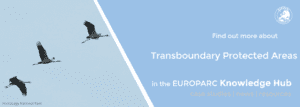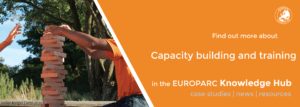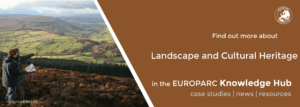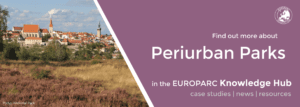30 years after the Fall of the Berlin Wall: Transboundary Parks Declaration
The Berlin Wall fell on the 9th November 1989. On the 30th anniversary, the European Transboundary Parks published a declaration highlighting the need to cooperate across frontiers.
Nature has no Borders
The EUROPARC’s network is characterised by making Protected Areas close to each other. They are however still separated by borders – virtual administrative, political and cultural walls – even in a now open Europe.
Since its birth, EUROPARC’s Transboundary Parks Programme, has embodied the spirit of the Fall of the Berlin Wall, on the basis of our day to day experience collaborating in the management of a shared biodiversity despite our political borders.
The experience of our history, our knowledge and values, led us to create a movement of active people, concretely co-operating and building projects to overcome barriers through the EUROPARC Transboundary Parks Programme: a true European project.
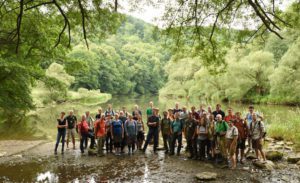
TransParcNet Meeting 2018. Author: D. Freudl
The inspiration derived from the Fall of the Wall is particularly evident given that most of our protected areas are located on the former Iron Curtain (now European Green Belt). Just looking at a map of Europe makes this very clear.
As equally evident is the energy and the will that the people involved in the Transboundary Programme put into the cooperation activities every day, driven by the pleasure of working together in once, long-time divided territories.
Commitment for peace, dialogue and nature protection
For these reasons and on this occasion we strongly declare our commitment for peace, dialogue and nature protection and our availability to support, in the frame of our institutional goals and skills, any initiative aimed at fostering cooperation between European states within and beyond the European Union.
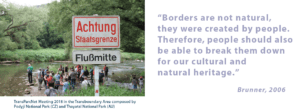
Europe is a complex continent with thousands of years of human interaction overlaying the natural world. The most obvious manifestations of that history are the many political borders that abound, and indeed change over time.
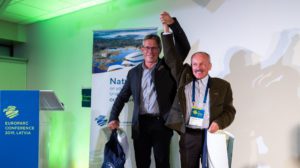
Award Ceremony at EUROPARC Conference 2019 – Welcome to the new Transboundary Park! Binntal – Veglia Devero Nature Park
Nature however, never recognizes these artefacts of human civilisation and our Protected Areas represent what is most special across our small, marvellous and populated continent and constitute a “shared European inheritance” of nature protection.
Yet in places borders create artificial barriers to the management of these valuable natural resources. The places where Protected Areas share a common political boundary bring these management issues into sharp focus and need special consideration.
The EUROPARC Transboundary “Following Natures Design” Programme seeks to support a process of mutual understanding, often between countries where history may have created mutual distrust, or administrative barriers and develop management tools to enable greater cooperative management.
Political borders create artificial barriers to the management of the valuable natural resources.
The Protected Areas awarded with the EUROPARC Transboundary Program Certificate compose the TransParcNet, an innovative platform for safeguarding cross-border biodiversity, ecosystem services and cultural landscapes, as well as inspiring and encouraging people for better understanding of the importance of transboundary cooperation.
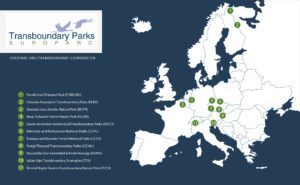
Download the Declaration and discover our Transboundary Areas.
Moreover, we would like to invite you and your networks to share your own memories of the fall of the Berlin Wall, by uploading a testimonial on the “My House of European History” platform. My House of European History aims to be a virtual library of testimonials and stories from people across Europe, and many nice uploads of people sharing their memories of the fall of the wall already feature.
Master programme in Management of Conservation Areas: Let’s talk about it!
Source: E.C.O. Institute of Ecology Facebook page
The Master programme in Management of Conservation Areas (MCA) opens international career paths in the management of Protected Areas, national parks, biosphere reserves or world heritage sites. The programme is offered by the E.C.O. Institute of Ecology together with the Carinthian University of Applied Sciences. Attend the info sessions to learn more!
Join the MCA Information Afternoons!
For anyone interested in the MCA Master programme, the E.C.O. Institute of Ecology is holding Information Afternoons in three different cities. The first session already took place in Klagenfurt (Austria) on Thursday 7 November, but if you have missed it, there are still two more to come in the following weeks.
Within the information afternoons, the MCA Team will present the programme, the teaching contents and the career prospects.
Don’t miss the opportunity to learn more and ask all your question!
For registrations and more information contact Caroline Fiedler at fiedler@e-c-o.at .
Information Afternoon in Bern, November 21
The second Information session will take place in Bern (Switzerland), on the 21st November 2019. The MCA Team will welcome you in the Berner Generationenhaus from 17:00 to 19:00.
Download the invitation with more details:
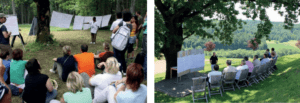
Source: MMCA flyer, e-c-o.at
Information Afternoon in Frankfurt am Main, November 27
The third info session will be held in Frankfurt am Main (Germany) on November 27th, at the Toyoko Inn Hotel, between 17:00 and 19:00.
Download the invitation with more details:
About the MCA Master programme
Unique in Europe, the comprehensive academic education allows for career growth in Protected Area management, in research and education, as well as in NGOs or international organizations. The key elements of the skills-oriented education are international cooperation and transcultural learning and working.
The study program comprises 120 ECTS, culminating in a Masters degree (M.Sc.) graduation. The course takes four semesters and can be completed while working full-time. In total, 64 attendance days are structured into eight modules of five to 13 days each. The courses take place at the Carinthian University of Applied Sciences as well as in selected Protected Areas in Central and Eastern Europe.
Next round: February 2020 – February 2022 (Application deadline: November 30, 2019).
Landscape design for people and biodiversity: a case from a post-mining area
Designing landscapes, Hoge Kempen National Park, BE - Source: Johan Van Den Bosch presentation
During the Conference 2019 in Latvia, EUROPARC held a number of workshops to discuss diverse topics relevant for Protected Areas management. In case you have not attended, or want to read about their outcomes, a series of online articles summarises the content of some of these workshops.
Including artefacts in Protected Areas
As an appetizer, Johan Van Den Bosch (Coordinator at Hoge Kempen National Park), explained the concept of the only National Park in Belgium, in which cultural landscapes and anthropogenic artefacts, like sand- and gravel pits, former coalmines, etc., are fully included and managed in the Protected Area. They are like a ‘matrix’ in which biodiversity is present and ecological processes take place.
Cultural landscapes and anthropogenic artefacts become a ‘matrix’ for biodiversity and ecological processes.
Visitor facilities are situated outside, and even some distance away from the National Park. In a wish to bring these facilities, so-called ‘Gateways to the National Park’, closer to the Park itself, policy-makers agreed to establish ‘grey zones’ between the gateway and the Protected Area.
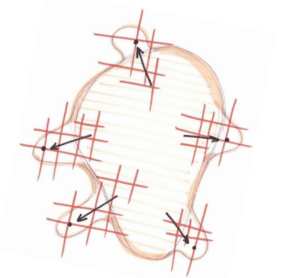
Source: Johan Van Den Bosch presentation
This resulted in a so-called expansive, rather than an invasive concept of visitor management and infrastructure. Specifically in very densely populated areas, this seems to be the only way to establish large Protected Areas and places good for people and for biodiversity. It enables to create simultaneously economic growth in tourism and new space for nature conservation.
Download the presentation: How can landscape design mimic nature to create places good for people and biodiversity?
In Europe, nature is a cultural phenomenon
…and the role of people creating nature – as well as destroying it – cannot be ignored. Our landscapes are like a clay tablet, where traces of past stories contribute to the present picture. What we do, add or remove, adds further layers into the future. Appreciation of nature connects aesthetics with cultural memory, as well as biodiversity.
It’s a great challenge for the management of Protected Areas to acknowledge the idea that
a landscape is like a biography of people living and working in it.
There is no problem with adding a new, 21st century-chapter to this biography. But make sure that there isn’t a chapter missing!
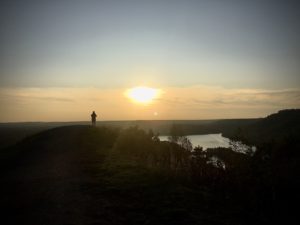
Hoge Kempen. Author: Barbara Pais
When we have the opportunity to create landscapes “from scratch”, like in post-mining areas, quarries, artificial coast-defending island, former brown-fields, natural forms and patterns result in more attractive landscapes.
But the main challenge is to kick-start ecological colonisation and succession, rather than establishing patterns and landforms by ‘gardening’.
Landscape design for people and biodiversity
Most managing agencies of Protected Areas agree that visitors who are enjoying the park are very welcome. It contributes to the public support, health care, local economy…
Unfortunately, it is sometimes seen as a ‘burden’; something to be in line with the will of policy-makers, rather than a core-issue of the management plan. It’s important to get rid of the false idea that the ecosystems and biodiversity are in a perfect state of conservation as long as people stay far away from them.
A good landscape design can create new places which are profitable for both people and biodiversity.
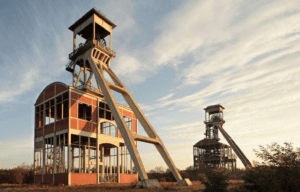
Mining towers as landscape memorials at the Hoge Kempen National Park (BE) Source: Johan Van Den Bosch presentation
While creating new habitats for endangered species is difficult, sometimes almost impossible and/or very costly, the habitat for nature-lovers is rather easy and even cheap (compared with other habitat restoration) to create. Everyone who is familiar with human behaviour knows what people going out for a nature-experience need: a viewpoint, diversity in landscapes, water ponds and sand dunes where they can play… and a pub!
When creating new habitats for nature lovers, it’s in the interest of both people and nature, to make it as natural and diverse as possible. Finally, creating places of beauty will be the most important ‘trigger’ for the broader public to become engaged in nature protection.
Give visitors a great and real intense experience, not a second hand ‘forest’ without any attractiveness.
Green exercise & outdoor sports in Periurban Parks: challenges & solutions
Source: Damien Prost-Romand presentation
During the Conference 2019 in Latvia, EUROPARC held a number of workshops to discuss diverse topics relevant to Protected Area management. In case you have not attended, or want to read about their outcomes, we summarised the content of some of these workshops in a series of online articles.
“Spending time in nature and practicing outdoor sports is good for our health”
said Dr William Bird, one of the keynote speakers EUROPARC Conference 2019, and author of “Nature and Public Health: the role of nature in improving the health of a population“.
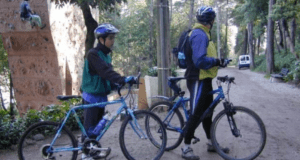
Source: Fernando Louro Alves presentation
Periurban Parks around cities offer natural landscapes where many urban dwellers come to spend time outdoors. In the past years, Periurban Parks have registered a huge increase of visitors numbers – both individuals and participants in collective sports events.
That is all good…until this increase becomes massive and starts creating problems among the users, and damage to species and their habitats.
In the last years, Periurban Parks have registered a huge increase of visitors numbers.
In order to discuss this issue, which represents one of the main current challenges for Periurban Parks, the Periurban Commission held the Workshop #5.2: How do we manage green exercise and the increase of outdoor sports in Periurban Parks?
The discussion focused on two main aspects:
- What can be done in terms of planning to better manage the increase of public use?
- What protocol can a park apply to minimise damages when organising a mass sports event?
Making green exercise compatible with biodiversity: a case study from Portugal
Download the presentation: Trails and zoning in Parque Florestal de Monsanto (Lisbon) devised to make green exercise and biodiversity as much compatible as possible
Presented by Fernando Louro Alves
In order to deal with the management of public use, Fernando insisted on the need to step back and carefully plan the park, giving special attention to mobility – especially slow mobility – and accessibility.
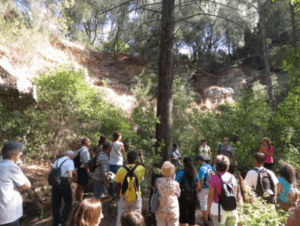
Source: Fernando Louro Alves presentation
The Monsanto Forest Park has been divided into several zones, based on different uses. For instance, the use of bikes is only allowed in one zone. However, bikers don’t always respect this regulation. At points of conflict, the Park has used conciliation participatory techniques to sort them out.
Trails, where the park wants to attract more visitors to, are clearly designed as such – they have permeable pavement, very good drainage systems and are made of native materials. These trails are beautifully designed and ranging different difficulty options.
Download the map of Parque Florestal de Monsanto
We need to step back, plan carefully and pay special attention to mobility and accessibility.
On the other hand, the park installed obstacles in trails where they intend to lower visitor numbers. Other measures, like promoting good network of public transport, reducing parking lots, implementing slow mobility etc., aim to reduce the traffic in the park’s surroundings.
The discussion in the first part of the workshop gave rise to several points:
- Bad use of parks with people not knowing it => Unconsciousness of visitors of their real impact
- The emergence of new modalities of outdoor adrenaline-like sports (down-hill descent) and engines (new type of bikes, electric bikes, scooters, etc.) => Staff is not prepared to deal with so many new activities in such short periods of time.
Limiting the negative impacts of sports events hosted by parks: a case study from France
Download the presentation: What interest does a park have in organizing or hosting sports events and what are the rules to be adopted to limit their negative impacts?
Presented by Damien Prost-Romand from the Grand Parc Miribel – Jonage in Lyon
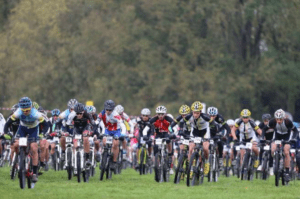
Source: Damien Prost-Romand presentation
For the Grand Parc Miribel-Jonage, the starting point is that collective sport events are good to promote physical health but also social cohesion; they bring economic benefits and create and reinforce the park’s identity. However, collective sport events might also create damage to habitats and sensitive species.
This is why the Grand Parc Miribel-Jonage, which is a Natura 2000 site, has established a protocol to regulate how mass events need to be organised and approved by the management entity.
Collective sports events promote physical health and social cohesion, but might also case damage to habitats and sensitive species.
During the discussion, many agreed on the general lack of political will and back-up of parks. Particularly, decision-makers usually:
- Do not respect the Parks’ carrying capacity limits. They always push to host the biggest run ever, biggest contest ever, etc. without paying attention to the consequences for the park.
- Do not provide enough resources for law enforcement.
Read the case study on hosting a mass event in a Natura 2000 site, the Grand Parc Miribel-Jonage.
Many of the challenges that Periurban Parks are facing, stem from the lack of understanding of the important role these spaces play for the good quality of life in cities. Acknowledging this fact, the Periurban Commission launched the position paper Periurban Parks, their place in EU policies at the EUROPARC Conference 2019.
Besides that, the commission is working on a Toolkit on Public Use Design & Management in Periurban Parks. The aim is to give practical advice on design and management measures to host different kinds of visitors, avoid conflicts among them and reduce impact on biodiversity.
If you have a case study or good practice that you would like to share with us, please submit them here. We will be happy to promote your success and inspire others!
